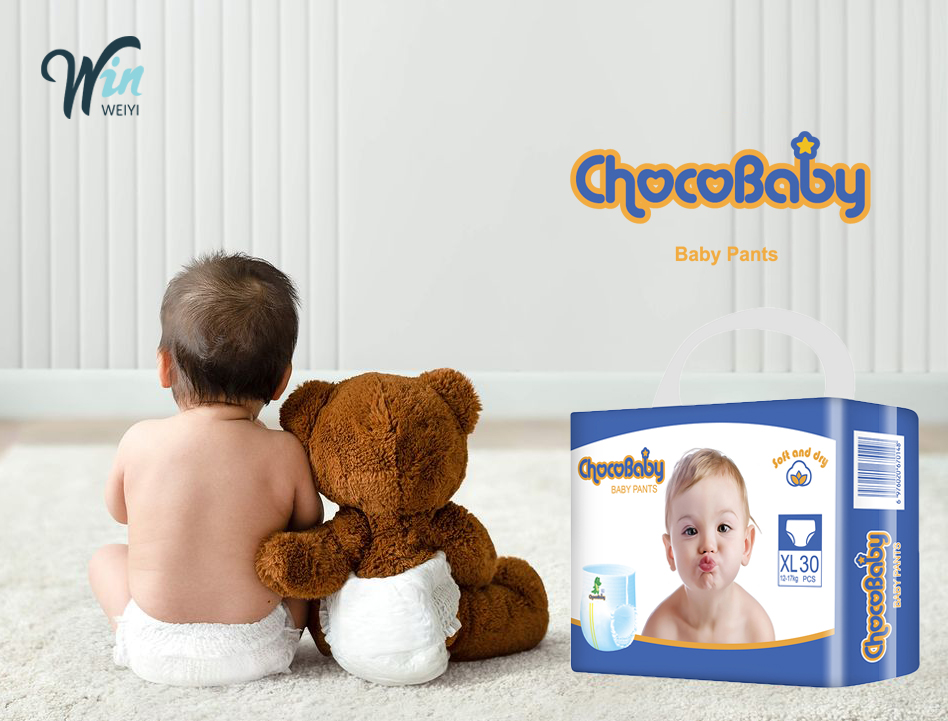24 Diaper Facts, How Many Do You Know? (1)
In the United States, 80% of babies use disposable diapers, while in the UK this figure reaches over 90%. New mothers and the elderly always have many questions and misunderstandings about disposable diapers. It is your choice to use diapers or disposable diapers, but it would be a pity if you miss it because of various misunderstandings.
1.Are diapers stuffy and not breathable? Aren’t they similar to sanitary napkins?
If you cut open diapers and sanitary napkins for comparison, you will find that the difference is very big. Diapers have diversion strips that allow urine to be dispersed throughout the diaper instead of being concentrated in one lump. Sanitary napkins only have a small area, and the secretions are concentrated near the private parts. Diapers are made of cotton and absorbent particles, while sanitary napkins are usually made of cotton. Some ultra-thin and breathable sanitary napkins also have particles, which are more comfortable than cotton.
The biggest difference is that the outer layer of the sanitary napkin is a layer of plastic film, which is also the film that makes people feel stuffy in order to prevent leakage. Diapers do not have this, so when we touch the outer layer of the baby’s diaper, it is always wet, but the inside is dry.
As for summer, is it necessary to change to thin diapers? This is necessary. If you are basically in an air-conditioned room, you can relax the requirements appropriately, because the hot and humid environment in summer will make the baby’s crotch more stuffy. More frequent changes and proper drying of the little butt are essential.

2. What kind of diapers are easy to wear and won’t squeeze the baby’s thighs?
First, pay attention to the design of the waist and waist stickers. Some diapers have 360-degree elastic waist and waist stickers, which can fit the baby’s body easily when turning left or right. Second, pay attention to the design of the leak-proof side. Choose diapers with elastic double leak-proof side, which are not only elastic, but also minimize the irritation to the baby’s delicate skin and will not leave red marks on the baby’s thighs.
When the baby is learning to crawl and stand and needs more space for exercise, you can use pull-up pants, which are like small underwear and easy to put on and take off.
3. How long does it take to use up the opened diapers?
Although diapers have a long shelf life, they can easily absorb water and go bad if not stored properly, especially in humid areas. It is recommended that mothers buy “fresh” diapers. In addition, it is best to use up diapers within 2-3 months after opening.
4. Can boys and girls use the same diapers?
Of course. It is best to choose diapers with a longer inner urine-absorbing layer for your baby. In this way, whether it is a boy or a girl, the urine will be absorbed quickly after urinating, reducing the contact time between the skin and the urine.
5. Until what age should diapers be used?
Generally speaking, when most babies are 18-24 months old, the muscles that control excretion are mature, and you can consider starting toilet training for your baby. When the baby can accurately express his or her desire to go to the toilet and gradually go to the toilet on his or her own, you can stop using diapers. This age can be too early or too late. Over-reliance on diapers will delay the time when the baby learns to defecate on his or her own.
6. What should I do if my baby’s diaper always leaks from the sides?
Choose diapers with double leak-proof hems for your baby. Especially the ones with raised hems on the inner thighs and leak-proof hems on the waist. This can effectively prevent side leakage when the baby urinates too much. In addition, diapers that are too big or too small can also cause this problem.
To be continued…
Remember to follow me now if you want more information.
